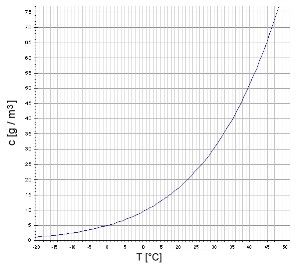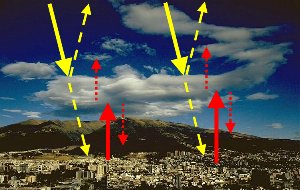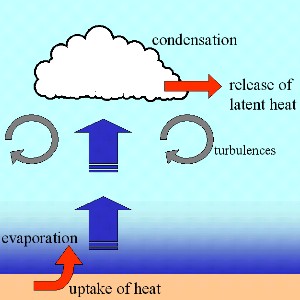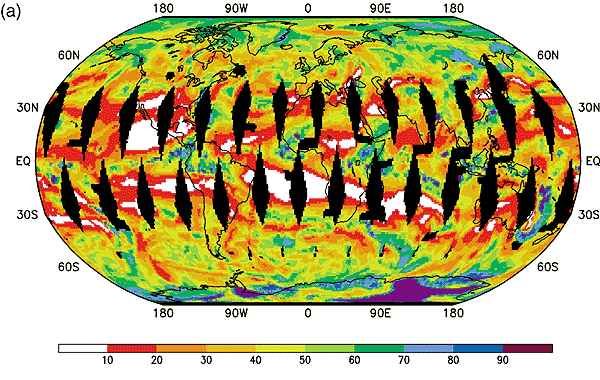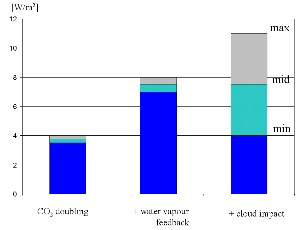 > English > Climate Encyclopaedia > Lower Atmosphere > more > 2. Radiation & greenhouse gases > - water
> English > Climate Encyclopaedia > Lower Atmosphere > more > 2. Radiation & greenhouse gases > - water
|
Lower AtmosphereRead more |
Water vapour and cloudsWater vapour is the most important greenhouse gas in the atmosphere and accounts for about 60% * of the total greenhouse effect. Until recently, Scientists assumed that the water vapour content of the atmosphere was more or less constant and that water vapour didn't contribute to the enhanced, human induced, greenhouse effect. However, as the Earth continues to warm, the amount of water vapour in the air will rise and water may cause greater warming in the future. * some references suggest that tropospheric water (including the long wave absorption by clouds) is responsible for 80% of the greenhouse effect. |
|
Probably the greatest uncertainties in future projections of climate arise because we don't know the impact of changing water vapour levels in the air and because we are unsure how clouds affect the amount of solar radiation reaching the surface of the Earth.
|
|
Generally, increasing air temperatures lead to increasing evaporation and more water vapour in the air. While ideal thermodynamic conditions are nearly fullfilled for evaporation processes in the tropospheric boundary layer (up to 1 to 2 km in altitude), conditions in the free troposphere above are much more complicated. It is here that the greenhouse potential of water vapour is likely to increase in the future.
|
|
Cloud formationThe consequence of increasing humidity is an increase in cloud cover. Clouds interact in two ways with radiation. On the one hand, they act like greenhouse gases, absorbing infra-red radiation from the Earth and trapping the heat in the lower atmosphere. On the other hand, they increase the Earth's albedo by reflecting incoming solar radiation back into space before it reaches the Earth, effectively cooling the planet. It strongly depends on the type of cloud which effect is strongest but it is assumed that, on average, the cooling effect dominates.
|
Twofold feedbackSo global warming is likely to both increase the water vapour content of the air and increase cloud formation. These two effects are likely to have opposite feedback effects. One probably leads to further warming, the other to cooling, although the role of high clouds is still unsure.
|
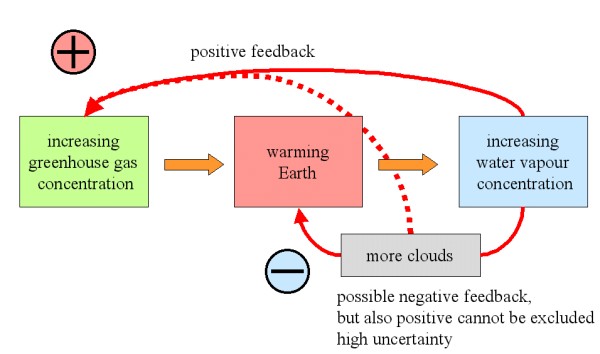 |
|
3. Feedbacks in the water cycle.Global warming leads to higher water vapour concentrations and more water vapour leads to further warming - a positive feedback effect leading to higher and higher temperatures. However increasing water vapour concentrations also leads to more clouds. An increase in clouds probably leads to a cooling since clouds can reflect incoming solar radiation back into space. However, some computer models suggest that high clouds may have a positive feedback effect and may encourage further warming. Our knowledge about clouds is not yet sufficient to explain exactly how they affect climate.
|
UncertaintiesLarge differences in the amount of cloud which forms and the amount of water vapour in the atmosphere are seen on regional scales. These scales are often smaller than the grid size used in climate models, so climate models don't take into account every cloud which appears in the atmosphere. The affect of water vapour and clouds on climate is also uncertain because many models also don't take into account:
|
- large scale dynamics and many others. The atmosphere is very dynamic and nowhere near a state of equilibrium. Latitute also affects how moisture is transported through the atmosphere:
|
|
|
|
Estimations of the water vapour and cloud feedback effectsCurrent estimations say that if we increase CO2 concentrations in the air to 560 ppm (double the preindustrial level of 280 ppm), the average temperature of the Earth will increase by between 1.5 and 4.5 °C. This wide range in estimates is mainly because the overall effect of clouds on our climate is still so uncertain.
|
A doubling of CO2 without any other change would lead to an additional radiative forcing of 3.5 to 4 W m-2, equivalent to a temperature increase of 1.2 °C. This value doubles to between 7 and 8 W m-2 if we take into account the positive feedback effect of water vapour alone. We now need to add in the impact of clouds, these may lead to a slight cooling of the planet (regarded as most likely) or to an additional warming. The uncertainty in this term is estimated to be between -3 and +3 W m-2 leading to an overall radiative forcing of about 4 to 11 W m-2 for a doubling of CO2 or a temperature increase between 1.5 and 4.5 °C. Comparing this range in possible temperatures to the 1.2 °C temperature rise which is estimated to come from the CO2 rise alone, you get an idea just how important it is to understand the impact of water vapour on our climate.
|
|
|
Related pages Find out more about the interaction of clouds and radiation and the impact on climate in:
About this page:author: Dr. Elmar Uherek - Max Planck Institute for Chemistry, Mainz, Germany
|

